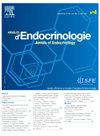Altitude and paraganglioma
IF 2.9
3区 医学
Q3 ENDOCRINOLOGY & METABOLISM
引用次数: 0
Abstract
The relationship between altitude and the development of paragangliomas (PGLs), rare tumors within the sympathetic nervous system has been suggested since the early 1970's. Here, we discuss how altitude, marked by lower barometric pressure and hypoxia (reduced oxygen partial pressure), may influence cancer rates. Chronic hypoxia triggers physiological changes, such as carotid body (CB) hyperplasia and a higher incidence of head and neck paragangliomas (HN-PGL) which has been reported in high-altitude populations, with a predominance of females among affected individuals. The involvement of hypoxia signalling in PGL tumorigenesis is further reinforced by the demonstration that genetic mutations, (particularly in VHL, SDHx and EPAS1 genes) cause a pseudo-hypoxic response. Furthermore, somatic mutations in EPAS1 are also linked to an increased risk of PGL in individuals with chronic hypoxemic conditions such as cyanotic congenital heart disease or haemoglobin diseases. Altogether, this review emphasizes the unique sensitivity of paragangliomas to hypoxic signalling, and shows that whether due to low environmental oxygen at high altitudes, diseases, or genetic mutations, hypoxia plays a pivotal role in PGL formation.
海拔和副神经节瘤。
副神经节瘤是一种罕见的交感神经系统肿瘤,自20世纪70年代初以来,海拔与副神经节瘤(PGLs)的发展之间的关系已经提出。在这里,我们讨论以较低的气压和缺氧(氧分压降低)为标志的海拔如何影响癌症发病率。据报道,在高海拔人群中,慢性缺氧会引发生理变化,如颈动脉体(CB)增生和头颈部副神经节瘤(HN-PGL)的发病率较高,且受影响个体中以女性为主。基因突变(尤其是VHL、SDHx和EPAS1基因)引起假性缺氧反应的证明进一步强化了缺氧信号在PGL肿瘤发生中的作用。此外,EPAS1的体细胞突变也与慢性低氧血症(如紫绀型先天性心脏病或血红蛋白疾病)患者的PGL风险增加有关。总之,这篇综述强调了副神经节瘤对缺氧信号的独特敏感性,并表明无论是由于高海拔低环境氧、疾病还是基因突变,缺氧在PGL形成中起着关键作用。
本文章由计算机程序翻译,如有差异,请以英文原文为准。
求助全文
约1分钟内获得全文
求助全文
来源期刊

Annales d'endocrinologie
医学-内分泌学与代谢
CiteScore
4.40
自引率
6.50%
发文量
311
审稿时长
50 days
期刊介绍:
The Annales d''Endocrinologie, mouthpiece of the French Society of Endocrinology (SFE), publishes reviews, articles and case reports coming from clinical, therapeutic and fundamental research in endocrinology and metabolic diseases. Every year, it carries a position paper by a work-group of French-language endocrinologists, on an endocrine pathology chosen by the Society''s Scientific Committee. The journal is also the organ of the Society''s annual Congress, publishing a summary of the symposia, presentations and posters. "Les Must de l''Endocrinologie" is a special booklet brought out for the Congress, with summary articles that are always very well received. And finally, we publish the high-level instructional courses delivered during the Henri-Pierre Klotz International Endocrinology Days. The Annales is a window on the world, keeping alert clinicians up to date on what is going on in diagnosis and treatment in all the areas of our specialty.
 求助内容:
求助内容: 应助结果提醒方式:
应助结果提醒方式:


